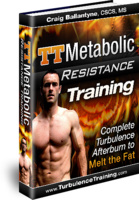Metabolic Training
 Hey folks, we are back today with Alwyn Cosgrove of Results Fitness who is also the author of “The New Rules Lifting”.
Hey folks, we are back today with Alwyn Cosgrove of Results Fitness who is also the author of “The New Rules Lifting”.
To bring you up to speed please jump back to part 3 , to learn more about disrupting the metabolism by create a metabolic disturbance.
If you would you can Click here to listen to the call.
****************
Craig: When I talked to you last time, you guys were doing that 30/20 metabolic training. That’s gone now basically from your system?
Alwyn: We were always doing that type of training. We just looked at how we could take that concept and customize it a little bit. I think there’s still a place for by design versus by default interval training. There is a place where you have to go again, no matter if you are feeling recovered or not.
The issue always with our clients was, “Can we get them to work hard enough in that short rest period?” That’s always an issue. Can they get their heart rate up, and have they recovered enough? If not, we’re just trending towards aerobics and we may as well just do aerobic training. If you’re not getting a high enough peak in the work period, you’re not getting low enough of a recovery in your rest period, it just sort of flat lines in between. We look for ways to avoid that.
We still have this idea that we want heavy days where the muscle is the limiting factor, and we want lighter days where metabolics is the limiting factor.
Craig: What do your strength training sessions look like?
Alwyn: First off, everyone does a dynamic warm up and then we have a core section where we do direct core training. We have a power session where we do something explosive, like a jump or medicine ball throw. Everyone does some power.
Then, it’s structured. We do non-competing pairs with short rest periods. We try to keep the exercises asymmetrical. I like the phrase “aliveness.” A sandbag rotational lunge has this constant little movement of the sandbag, and because of the rotational exercise and offset loading, no two reps are identically the same.There’s a metabolic load to that that is beyond the actual reps and loading because of that aliveness.
We favor a lot of what we call self-limiting exercises. These are exercises that, for want of a better term, have a built in autocorrect. You immediately know when you’re doing it wrong. For example, you can do a lot of deadlifts wrong.
You can round your back and not really feel it. You can do a lot of squats wrong. Certain things, like pushing a sled, are hard to do wrong because if you can’t do another quality rep, the sled stops moving. We use a lot of those types of exercises.
That structure hasn’t evolved that much. I think we’ve got that dialed in. The exercise selection is a little more preference towards asymmetrical work, and a bigger preference towards aliveness. Those would be things like the TRX and the sandbags. For your work to rest rate, we have traditional fixed work to fixed rest strength training. You do ten reps and rest 60 seconds. Both are fixed.
We could have a variable work to fixed rest, which is you train to failure, then you rest 60 seconds. Then you add some of the density training, where you do as many reps as you want and get as many sets as you can done in ten minutes. Both your work and your rest are variable.
There are three types of ways to program it. Remember the 5/3/1 model where there are fixed rest periods and two sets of fixed work. The last set is variable work. There’s a different metabolic effect there than fixed work. The best advice I can give on turbulence training is select what type of volume of work you want to do. Select the plan you’re doing and select good exercises.
Start thinking doing three sets of ten of two exercises would be six sets with 60 second rest will be somewhere around 12 minutes of work. A minute a set, a minute rest; two minutes a set; three sets each exercise, six sets total for 12 minutes of work.
What if we changed it to do as many sets as you can in 12 minutes for one cycle of training? The next cycle of training I want you to do those three sets of ten in as little time as possible. We get the same exercises in the same volume, but with three ways of programming it that have three completely different metabolic loads on the body. If you start looking at those things, we can the same knowledge and exercises and deliver it slightly different.
Craig: Slightly modify and get the rest periods right for your client so they can do the most work. Doing the most work is what it really comes down to.
Alwyn: When I first wrote the Hierarchy of Fat Loss article, at first people were negative, and they fought me. Then they liked it. There really wasn’t that much to it because all I said was, “Figure out how much training time you have and do the hardest thing first. If you only have two hours a week, only do strength training. If you have four hours a day, there’s a lot of stuff you can do.”
All I did was look at a training week and say, “If you can only come in two to three times a week, then strength training will be the biggest bang for your buck.”
The only thing we’re finding, Craig, is if you do a great job with your fat loss clients, which all the turbulence trainers do, they cease to be fat loss clients at some point and become what we call “the executive athlete.” This is a category of client that is already in shape and they may exercise for their hobby. This may be what they do for fun; they go to the gym. If you think about why gyms started, it was always a means to an end. Now it’s an end unto itself.
These clients are starting to look for things like mud runs. That’s something you, Craig, are starting to do. They’ll do the occasional five or ten kilometre run. We have one lady who has done a mud run, a five kilometre run, a triathlon, and power lifting. She also did The Jeans Challenge, the eight week fat loss challenge.
These people need short term goals. They’ve almost become a type of athlete. Obviously if you’re working with a soccer player, they have competitions to peak for, training, and they have cup games and so on. If you look at the year, everything fits together.
When someone’s goal is to lose 20 pounds and they’ve lost 20 pounds, what do you do to keep them? Fat loss is no longer the goal, and maintenance will only motivate someone for so long. There’s a need for a new style of training. It’s creating athletes out of people who never thought they were athletes. We call it the “training of the executive athlete.” That’s the nickname we call them.
Picture a client that’s maybe been with you for a while and has gotten in shape. They’re no longer a beginner, but pure aesthetic training is no longer why they’re there.
Ok, we’ll end it here to day with great summary and pick it up tomorrow in part 5, with some exercise suggestions for the beginner.
Speaking of beginner workouts…
We have 10 beginner workouts that you can do for 4 weeks in the new Home Workout Revolution (HWR) program.
Craig Ballantyne, CTT
Certified Turbulence Trainer